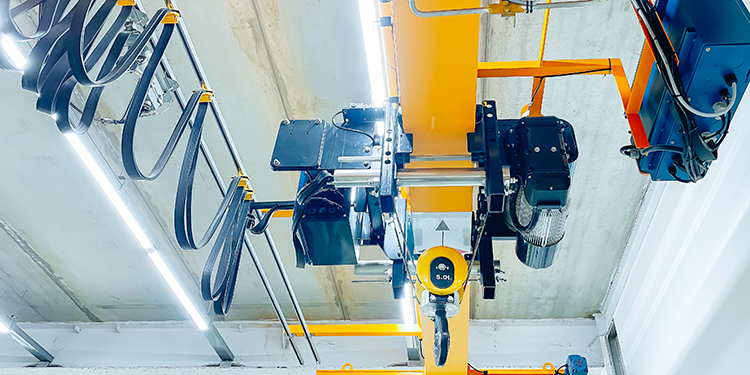
In addition to publishing guidance for the proper operation of hoists, the technical committee of the Hoist Manufacturers Institute (HMI) hosted a recent webinar to elaborate on select recommended practices. “Dos and Don’ts of Safe Hoist Operation” presents several potential hoisting hazards and approaches to mitigate associated risks. A series of speakers in the HMI webinar explored a range of hoist safety best practices when using both powered and manual equipment.
Presenting the webinar are experts from several HMI member companies. They include:
- Matthew Frazier, Senior Manager of Engineering in New Product Development at Columbus McKinnon
- Bob Burkey, Senior Engineering Advisor at Columbus McKinnon
- Eric Weber, Wright Product Manager at Acco Material Handling
- Troy Thomas, Manager of Project Development Engineering at Harrington Hoists
- Joe Eudy, Manager of Engineering at Coffing Hoists
“Although HMI provides a complete list of dos and don’ts for powered hoists and manual hoists, the technical committee wanted to call attention to several specific items we felt were of particular importance or might need clarification,” said Burkey, explaining the motivation behind the session.
Training a Critical Hoist Safety Best Practice
“Many of the webinar presenters have spent our careers designing safe hoists,” Burkey continued. “What we’ve all come to realize is that safety ultimately comes down to hoist operation. That’s why the session emphasizes operator training first and foremost.”
Not only does HMI strongly recommend comprehensive operator training in the safe use of a hoist, but the Occupational Safety and Health Administration (OSHA) and American Society of Mechanical Engineers (ASME) do too, he added.
“Proper training includes a review of the hoist’s manual, HMI’s recommended operating practices, and hands-on use of the hoist,” noted Burkey. “No training is complete until the operator has demonstrated the ability to operate the hoist in the actual application.”

Pre-Shift Hoist Inspections Key to Safety
Prior to using the hoist, a pre-shift hoist inspection should occur, explained Frazier. He cited four separate OSHA and ASME codes and standards about these assessments:
- OSHA-CFR 29 Part 1910.179 for overhead and gantry cranes (to which hoists attach) requires inspections of new and modified cranes and hoists.
- ASME B30.16 Overhead Hoists (Underhung) mandates that qualified, trained persons conduct regular inspections of powered underhung overhead hoists.
- ASME B30.21 Lever Hoists calls for regular inspections of manually powered lever hoists performed by qualified persons trained to do so.
- ASME B30.10 Hooks covers the visual inspection of hooks and slings used with hoists.
“For operations needing more help with establishing a pre-shift hoist inspection process, HMI offers a comprehensive guide. HMI 100.24 Hoist Inspection and Maintenance Manual is a free download,” said Frazier. “The manual also includes helpful checklists that detail these key inspection areas. Further, HMI’s technical committee produced a webinar focused solely on the topic of pre-shift hoist inspections.”
Important Considerations in Electric and Manual Hoist Operation
Burkey also detailed several other hoist safety best practices for both powered and manual hoists. These include:
- Never operate a hoist with frayed wire rope or twisted, kinked, or worn load chain.
- Never lift loads greater than the hoist’s rated capacity.
- Never use the hoist’s overload device as a means to weigh a load.
- Never use a hoist to lift or support people.
- Never suspend a load over people.
- Only lift loads centered under the hoist; never attempt a side-pull.
- Never use a load wire, rope, or chain as a sling around a load.
- If a load hook has a latch, make sure it closes securely over the load’s connection point.
- Never leave a suspended load unattended.
Weber presented several hoist safety best practices specific to electric-powered hoists, and to manual hoists.

“Manual hoists should only be operated by hand,” he advised. “Applying a power source to a manual hoist has the potential of operating the hoist beyond its intended design parameters. That can cause dangerous brake or mechanical failures. For those reasons both OSHA and ASME expressly forbid operating a manual hoist with anything but manual power.”
Weber also explained why only one operator should pull on the hand chain of a manual hoist at a time. “More than one operator pulling on the chain can cause a hoist overload because it’s producing twice the design input,” he said. “The exception to this rule is when a hoist has two separate hoisting mechanisms, each one intended for use by two individual operators.”
Recommended Hoist Safety Best Practices for Parking Loads
Thomas reviewed several best practices for parking a load to ensure the safety of the operation and its personnel.
“It’s always a necessity to ensure all people and objects are clear of the load path,” he said. “To do this, make sure there is a clear and unobstructed view of where you need to park the load prior to making the first move. Then, before moving that load, make sure the position where that load is going to be parked is clear of obstructions.”
Thomas also advised against attempting to move or adjust rigging on a suspended load. “If the rigging does not look safe, always bring that load carefully and safely back to rest at ground level. Then make the adjustment to the rigging,” he said. “Any attempt to adjust or remove rigging while that load is still suspended could result in catastrophic failure or a load drop. That could cause serious injury or even death. Never take the chance.”
The webinar concluded with a series of questions from attendees and answers from the presenters.

Learn More About Hoist Dos and Don’s
In addition to presenting the hoist safety best practices webinar publications, HMI offers a variety of other technical resources — including a comprehensive library of product guides; a hoist certification program; OSHA Alliance safety tip sheets, fact sheets and quick cards; multiple technical papers and more — via its website at www.MHI.org/hmi.



